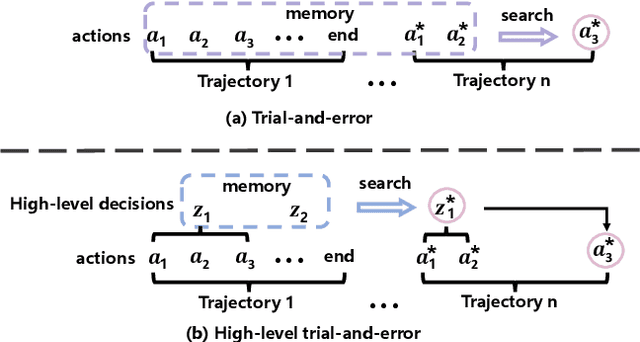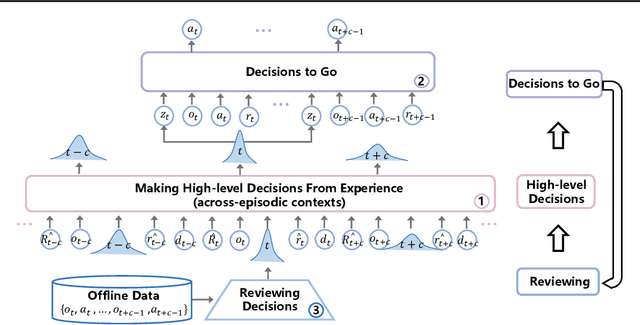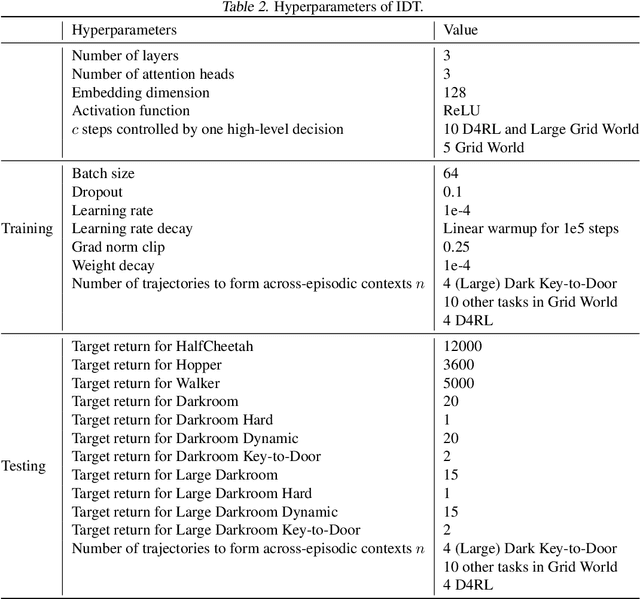Hechang Chen
Agentic Robot: A Brain-Inspired Framework for Vision-Language-Action Models in Embodied Agents
May 29, 2025Abstract:Long-horizon robotic manipulation poses significant challenges for autonomous systems, requiring extended reasoning, precise execution, and robust error recovery across complex sequential tasks. Current approaches, whether based on static planning or end-to-end visuomotor policies, suffer from error accumulation and lack effective verification mechanisms during execution, limiting their reliability in real-world scenarios. We present Agentic Robot, a brain-inspired framework that addresses these limitations through Standardized Action Procedures (SAP)--a novel coordination protocol governing component interactions throughout manipulation tasks. Drawing inspiration from Standardized Operating Procedures (SOPs) in human organizations, SAP establishes structured workflows for planning, execution, and verification phases. Our architecture comprises three specialized components: (1) a large reasoning model that decomposes high-level instructions into semantically coherent subgoals, (2) a vision-language-action executor that generates continuous control commands from real-time visual inputs, and (3) a temporal verifier that enables autonomous progression and error recovery through introspective assessment. This SAP-driven closed-loop design supports dynamic self-verification without external supervision. On the LIBERO benchmark, Agentic Robot achieves state-of-the-art performance with an average success rate of 79.6\%, outperforming SpatialVLA by 6.1\% and OpenVLA by 7.4\% on long-horizon tasks. These results demonstrate that SAP-driven coordination between specialized components enhances both performance and interpretability in sequential manipulation, suggesting significant potential for reliable autonomous systems. Project Github: https://agentic-robot.github.io.
Decision Flow Policy Optimization
May 26, 2025Abstract:In recent years, generative models have shown remarkable capabilities across diverse fields, including images, videos, language, and decision-making. By applying powerful generative models such as flow-based models to reinforcement learning, we can effectively model complex multi-modal action distributions and achieve superior robotic control in continuous action spaces, surpassing the limitations of single-modal action distributions with traditional Gaussian-based policies. Previous methods usually adopt the generative models as behavior models to fit state-conditioned action distributions from datasets, with policy optimization conducted separately through additional policies using value-based sample weighting or gradient-based updates. However, this separation prevents the simultaneous optimization of multi-modal distribution fitting and policy improvement, ultimately hindering the training of models and degrading the performance. To address this issue, we propose Decision Flow, a unified framework that integrates multi-modal action distribution modeling and policy optimization. Specifically, our method formulates the action generation procedure of flow-based models as a flow decision-making process, where each action generation step corresponds to one flow decision. Consequently, our method seamlessly optimizes the flow policy while capturing multi-modal action distributions. We provide rigorous proofs of Decision Flow and validate the effectiveness through extensive experiments across dozens of offline RL environments. Compared with established offline RL baselines, the results demonstrate that our method achieves or matches the SOTA performance.
Analytic Energy-Guided Policy Optimization for Offline Reinforcement Learning
May 03, 2025Abstract:Conditional decision generation with diffusion models has shown powerful competitiveness in reinforcement learning (RL). Recent studies reveal the relation between energy-function-guidance diffusion models and constrained RL problems. The main challenge lies in estimating the intermediate energy, which is intractable due to the log-expectation formulation during the generation process. To address this issue, we propose the Analytic Energy-guided Policy Optimization (AEPO). Specifically, we first provide a theoretical analysis and the closed-form solution of the intermediate guidance when the diffusion model obeys the conditional Gaussian transformation. Then, we analyze the posterior Gaussian distribution in the log-expectation formulation and obtain the target estimation of the log-expectation under mild assumptions. Finally, we train an intermediate energy neural network to approach the target estimation of log-expectation formulation. We apply our method in 30+ offline RL tasks to demonstrate the effectiveness of our method. Extensive experiments illustrate that our method surpasses numerous representative baselines in D4RL offline reinforcement learning benchmarks.
GRAIN: Multi-Granular and Implicit Information Aggregation Graph Neural Network for Heterophilous Graphs
Apr 09, 2025Abstract:Graph neural networks (GNNs) have shown significant success in learning graph representations. However, recent studies reveal that GNNs often fail to outperform simple MLPs on heterophilous graph tasks, where connected nodes may differ in features or labels, challenging the homophily assumption. Existing methods addressing this issue often overlook the importance of information granularity and rarely consider implicit relationships between distant nodes. To overcome these limitations, we propose the Granular and Implicit Graph Network (GRAIN), a novel GNN model specifically designed for heterophilous graphs. GRAIN enhances node embeddings by aggregating multi-view information at various granularity levels and incorporating implicit data from distant, non-neighboring nodes. This approach effectively integrates local and global information, resulting in smoother, more accurate node representations. We also introduce an adaptive graph information aggregator that efficiently combines multi-granularity and implicit data, significantly improving node representation quality, as shown by experiments on 13 datasets covering varying homophily and heterophily. GRAIN consistently outperforms 12 state-of-the-art models, excelling on both homophilous and heterophilous graphs.
Optimizing Case-Based Reasoning System for Functional Test Script Generation with Large Language Models
Mar 26, 2025Abstract:In this work, we explore the potential of large language models (LLMs) for generating functional test scripts, which necessitates understanding the dynamically evolving code structure of the target software. To achieve this, we propose a case-based reasoning (CBR) system utilizing a 4R cycle (i.e., retrieve, reuse, revise, and retain), which maintains and leverages a case bank of test intent descriptions and corresponding test scripts to facilitate LLMs for test script generation. To improve user experience further, we introduce Re4, an optimization method for the CBR system, comprising reranking-based retrieval finetuning and reinforced reuse finetuning. Specifically, we first identify positive examples with high semantic and script similarity, providing reliable pseudo-labels for finetuning the retriever model without costly labeling. Then, we apply supervised finetuning, followed by a reinforcement learning finetuning stage, to align LLMs with our production scenarios, ensuring the faithful reuse of retrieved cases. Extensive experimental results on two product development units from Huawei Datacom demonstrate the superiority of the proposed CBR+Re4. Notably, we also show that the proposed Re4 method can help alleviate the repetitive generation issues with LLMs.
A Survey on Post-training of Large Language Models
Mar 08, 2025Abstract:The emergence of Large Language Models (LLMs) has fundamentally transformed natural language processing, making them indispensable across domains ranging from conversational systems to scientific exploration. However, their pre-trained architectures often reveal limitations in specialized contexts, including restricted reasoning capacities, ethical uncertainties, and suboptimal domain-specific performance. These challenges necessitate advanced post-training language models (PoLMs) to address these shortcomings, such as OpenAI-o1/o3 and DeepSeek-R1 (collectively known as Large Reasoning Models, or LRMs). This paper presents the first comprehensive survey of PoLMs, systematically tracing their evolution across five core paradigms: Fine-tuning, which enhances task-specific accuracy; Alignment, which ensures alignment with human preferences; Reasoning, which advances multi-step inference despite challenges in reward design; Efficiency, which optimizes resource utilization amidst increasing complexity; and Integration and Adaptation, which extend capabilities across diverse modalities while addressing coherence issues. Charting progress from ChatGPT's foundational alignment strategies to DeepSeek-R1's innovative reasoning advancements, we illustrate how PoLMs leverage datasets to mitigate biases, deepen reasoning capabilities, and enhance domain adaptability. Our contributions include a pioneering synthesis of PoLM evolution, a structured taxonomy categorizing techniques and datasets, and a strategic agenda emphasizing the role of LRMs in improving reasoning proficiency and domain flexibility. As the first survey of its scope, this work consolidates recent PoLM advancements and establishes a rigorous intellectual framework for future research, fostering the development of LLMs that excel in precision, ethical robustness, and versatility across scientific and societal applications.
Solving Continual Offline RL through Selective Weights Activation on Aligned Spaces
Oct 21, 2024Abstract:Continual offline reinforcement learning (CORL) has shown impressive ability in diffusion-based lifelong learning systems by modeling the joint distributions of trajectories. However, most research only focuses on limited continual task settings where the tasks have the same observation and action space, which deviates from the realistic demands of training agents in various environments. In view of this, we propose Vector-Quantized Continual Diffuser, named VQ-CD, to break the barrier of different spaces between various tasks. Specifically, our method contains two complementary sections, where the quantization spaces alignment provides a unified basis for the selective weights activation. In the quantized spaces alignment, we leverage vector quantization to align the different state and action spaces of various tasks, facilitating continual training in the same space. Then, we propose to leverage a unified diffusion model attached by the inverse dynamic model to master all tasks by selectively activating different weights according to the task-related sparse masks. Finally, we conduct extensive experiments on 15 continual learning (CL) tasks, including conventional CL task settings (identical state and action spaces) and general CL task settings (various state and action spaces). Compared with 16 baselines, our method reaches the SOTA performance.
Continual Diffuser (CoD): Mastering Continual Offline Reinforcement Learning with Experience Rehearsal
Sep 04, 2024



Abstract:Artificial neural networks, especially recent diffusion-based models, have shown remarkable superiority in gaming, control, and QA systems, where the training tasks' datasets are usually static. However, in real-world applications, such as robotic control of reinforcement learning (RL), the tasks are changing, and new tasks arise in a sequential order. This situation poses the new challenge of plasticity-stability trade-off for training an agent who can adapt to task changes and retain acquired knowledge. In view of this, we propose a rehearsal-based continual diffusion model, called Continual Diffuser (CoD), to endow the diffuser with the capabilities of quick adaptation (plasticity) and lasting retention (stability). Specifically, we first construct an offline benchmark that contains 90 tasks from multiple domains. Then, we train the CoD on each task with sequential modeling and conditional generation for making decisions. Next, we preserve a small portion of previous datasets as the rehearsal buffer and replay it to retain the acquired knowledge. Extensive experiments on a series of tasks show CoD can achieve a promising plasticity-stability trade-off and outperform existing diffusion-based methods and other representative baselines on most tasks.
Contextual Distillation Model for Diversified Recommendation
Jun 13, 2024



Abstract:The diversity of recommendation is equally crucial as accuracy in improving user experience. Existing studies, e.g., Determinantal Point Process (DPP) and Maximal Marginal Relevance (MMR), employ a greedy paradigm to iteratively select items that optimize both accuracy and diversity. However, prior methods typically exhibit quadratic complexity, limiting their applications to the re-ranking stage and are not applicable to other recommendation stages with a larger pool of candidate items, such as the pre-ranking and ranking stages. In this paper, we propose Contextual Distillation Model (CDM), an efficient recommendation model that addresses diversification, suitable for the deployment in all stages of industrial recommendation pipelines. Specifically, CDM utilizes the candidate items in the same user request as context to enhance the diversification of the results. We propose a contrastive context encoder that employs attention mechanisms to model both positive and negative contexts. For the training of CDM, we compare each target item with its context embedding and utilize the knowledge distillation framework to learn the win probability of each target item under the MMR algorithm, where the teacher is derived from MMR outputs. During inference, ranking is performed through a linear combination of the recommendation and student model scores, ensuring both diversity and efficiency. We perform offline evaluations on two industrial datasets and conduct online A/B test of CDM on the short-video platform KuaiShou. The considerable enhancements observed in both recommendation quality and diversity, as shown by metrics, provide strong superiority for the effectiveness of CDM.
In-Context Decision Transformer: Reinforcement Learning via Hierarchical Chain-of-Thought
May 31, 2024



Abstract:In-context learning is a promising approach for offline reinforcement learning (RL) to handle online tasks, which can be achieved by providing task prompts. Recent works demonstrated that in-context RL could emerge with self-improvement in a trial-and-error manner when treating RL tasks as an across-episodic sequential prediction problem. Despite the self-improvement not requiring gradient updates, current works still suffer from high computational costs when the across-episodic sequence increases with task horizons. To this end, we propose an In-context Decision Transformer (IDT) to achieve self-improvement in a high-level trial-and-error manner. Specifically, IDT is inspired by the efficient hierarchical structure of human decision-making and thus reconstructs the sequence to consist of high-level decisions instead of low-level actions that interact with environments. As one high-level decision can guide multi-step low-level actions, IDT naturally avoids excessively long sequences and solves online tasks more efficiently. Experimental results show that IDT achieves state-of-the-art in long-horizon tasks over current in-context RL methods. In particular, the online evaluation time of our IDT is \textbf{36$\times$} times faster than baselines in the D4RL benchmark and \textbf{27$\times$} times faster in the Grid World benchmark.
 Add to Chrome
Add to Chrome Add to Firefox
Add to Firefox Add to Edge
Add to Edge